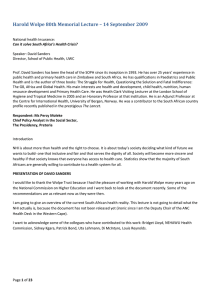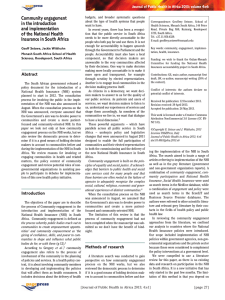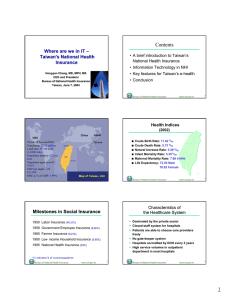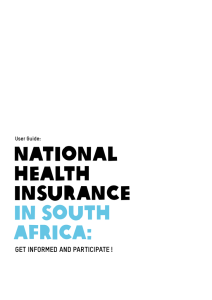Okorafor_AfHEA Oral Presentation_15 March
advertisement
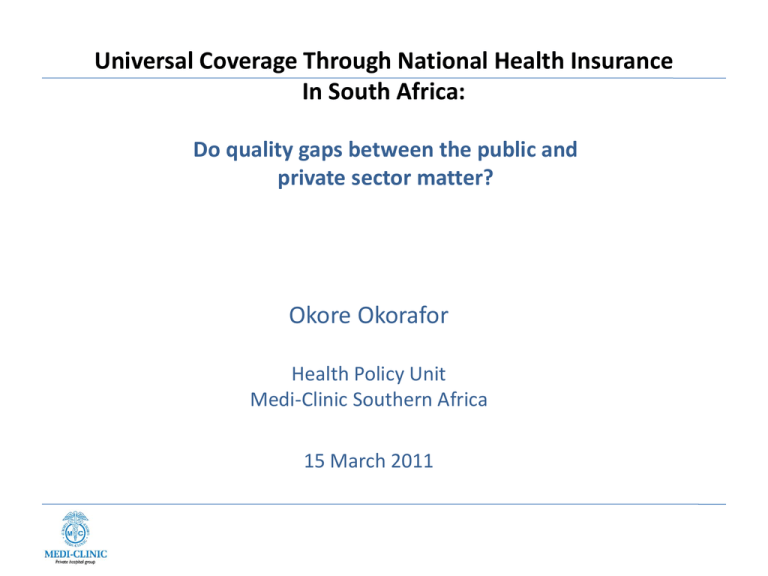
Universal Coverage Through National Health Insurance In South Africa: Do quality gaps between the public and private sector matter? Okore Okorafor Health Policy Unit Medi-Clinic Southern Africa 15 March 2011 Overview of the Presentation • Setting the context • Objectives of the Study • Literature & Conceptual Framework • Methods and results • Policy Implications Context: Dual Healthcare System Medical Scheme Contributions General taxes Medical Schemes (PHI) Public healthcare budget Out of pocket payments Public Providers 46% of Total Health Expenditure Private Providers 54% of Total Health Expenditure Is there a need for a Health reform? Private Sector •Higher Quality of Care •Wealthier members of the population •Rising premiums a concern for affordability INEQUITY Public sector •Lower Quality of Care •Poorer members of the population •Deteriorating quality a concern for acceptability Quality Comparison – Public vs Private Quality Indicator Public facility Private facility Facilities not clean 5.7% 1.4% Long waiting time 40.9% 10.5% Drugs that were needed, not available 16.7% 2.5% Staff rude or uncaring, or turned patient away 10.5% 2.4% Data Source: 2008 General Household Survey Palmer N. 1999. Patient choice of primary health care provider. South African Health Review. Durban: Health Systems Trust Gilson, L. and McIntyre, D. 2007. Post-Apartheid Challenges: Household Access and Use of Health Care in South Africa. International Journal of Health Services, 37 (4): 673-391. Burger, R and Van der Berg, S. 2008. How well is the South African public health care system serving its people? 2008 Transformation Audit: Risk and Opportunity. Cape Town: Institute of Justice and Reconciliation. Quality: Challenges faced in the public sector • Challenges faced in the public system – – – – Lack of managerial capacity Insufficient decentralisation of managerial authority Lack of accountability within the system (DBSA 2008) Severe shortage of health professionals (42.5% of posts are vacant) (Econex 2009) – Poor disciplinary procedures and corruption – Poor technology management, unsatisfactory maintenance and repairs – Delayed response to quality improvement requirements (Shisana 2011) • Concern around ability to improve quality of health care services in public sector if additional financial resources are made available! NHI Proposal & Principles • No official Government proposal; but ANC (2010)… – – – – Free at the point of care/use Choice of provider Mandatory progressive contribution according to ability to pay Universal access to health services that meet established quality standards – Single funder – NHI Fund to be established in 5 years – Full implementation of NHI in 14 years (2025) • Public is free to continue with medical scheme (PHI) cover only after contributing to the NHI Fund Financing the NHI • Funding sources considered.. – – – – – Pay-roll taxes (from less than 1% to 7-8%) Increase in VAT Surcharge on taxable income General taxation Elimination of income tax subsidy (medical scheme members) • Implicit – reduction of the private sector by increasing the opportunity cost of voluntary private health insurance. Objective of the Study • Estimate the likely impact of the NHI on the medical schemes market in South Africa – NHI pay-roll tax – Elimination of the income tax subsidy for medical scheme members • Two schools of thought – Income shock will significantly reduce the demand for PHI – Medical scheme members will re-prioritise their expenditure basket to ensure that they are able to access private health care Literature & Conceptual Framework • A lot of work has been done on the demand for voluntary PHI within the context of a universal NHS – Heterogeneity of the population – Existence of a quality gap • Conceptual Framework UPHI (QPHI, y – p, µ) > UNPHS(QNPHS, y, µ) • • • • • • • UPHI : utility derived from the use of private health care through PHI UNPHS : utility derived from the use of public health care QPHI : quality of care (perceived or actual) obtained in the private sector QNPHS : quality of care (perceived or actual) obtained in the public sector y: represents income p: is the premium paid for private health insurance μ: is the probability of being sick (greater than 0) Conceptual framework (contd..) • Even where QPHI > QNHS, it is necessary that: U (QPHI – QNHS) ≥ |U (y – p)| • Deduction – Price elasticity of demand for PHI is higher if the quality gap between the public and private sector is small. – Price elasticity of demand for PHI is low if the quality gap between the public and private sector is large. Level of substitutability Methods • Data source: 2005/2006 Income and Expenditure Survey (21,144 households and 84,978 individuals) • Regression analysis (probit model) Model 1: PHI = f (α + β1Incomet + β2X2 + ... + βkXk) Model 2: PHI = f (α + β1Incomet+1 + β2X2 + ... + βkXk) Incomet+1 = Income less NHI tax and Income subsidy Other variables: education, presence of child/elderly in household, household size and area of residence Limitations of the Study • Income tax subsidy should ideally be calculated based on tax-rate of premium payer. Due to lack of information on premium payer, average household tax rate (per household is used) • IES of 2005/06 (5 years old) • SA tax brackets used as boundaries for progressive NHI tax Results Dependent Variable = Membership to Medical Scheme Independent Variables Per capita income Household head level of education: category 1 (no schooling) Household head level of education: category 2 (incomplete primary) Household head level of education: category 3 (incomplete secondary) Household head level of education: category 4 (complete secondary) Household head level of education: category 6 (tertiary education) Area type (rural or urban) Household size Presence of child under 5 in household Presence of elderly over 64 in household Obs. P = .172 Pred P= .106 (at x-bar) Number of observations = 21068 Prob >chi2 = 0.000 Pseudo R2 = 0.3418 Coefficients (dF/dx) 2.53e-06 -0.154 -0.161 -0.167 -0.073 0.044 0.085 0.015 -0.012 0.041 P>|z| 0.000 0.000 0.000 0.000 0.000 0.046 0.000 0.000 0.145 0.000 Results: Predicted change in medical schemes market Predicted proportion with medical scheme membership (Incomet) Predicted proportion with medical scheme membership (Incomet+1) Predicted Change 0.1672 0.1654 1.08% • The magnitude of the change in the medical schemes market indicates a significant quality gap between the public and private sector. • Size of the medical schemes market more responsive to changes in quality within the public sector • Further Implications for the SA health sector! Implications & Recommendation • Government needs to focus much more on improving the quality of care in the public sector. – Systematic problems – Additional finances will not improve quality on its own • Inefficiency will be introduced in the system if the quality of care in the public sector is not significantly improved – Medical scheme members [NHI tax & income tax subsidy] – Non scheme members [NHI tax] Additional financial burden – No additional benefit?








